| Volume
77
July 2002
Part Two: The Puerto Escondido/Loreto Cruising Grounds
An Unexpected Road Trip to Cabo San Lucas
On July 15, we joined Terry Kennedy and a group
of three other divers on Manta to enjoy one of Terry’s “secret”
sites out in the middle of the channel. The site was a mound, the
top of which was about 60' deep, although you could go as deep as
115'. Being conservative types (and possibly turning the "wrong"
way on our own) Don and I kept our dive along the more shallow part
of the cobblestone reef. We were plenty delighted; fish were everywhere.
There were multiple huge green morays, including two in one hole.
There were dozens of salad-plate sized bulls-eye rays that Terry
later told us can give you quite a shock! (Reminds you not to touch
things you don’t know about!) There were swarms of the lovely
blue and yellow bicolor chromis and amongst them swam large trigger
fish, huge golden grouper and hundreds of cabrilla of "good
eating size" all unconcerned at our presence! Temperature was
nice, in the high 70s, viz was a decent 30-40', and all in all we
were quite encouraged. We started up the ascent line after 27 minutes
with everyone else (they'd all been down to 115' in the same time
frame!) well within the dive tables and inside the dive computer's
caution zone. Ascent was normal and we did a 3 min safety stop.
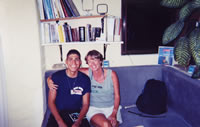 So,
I was pretty amazed to wake up at midnight with my left arm asleep
and mild pains in my left hip, elbow and shoulder! The arm woke
up, but the joint pains were not imaginary, so I pulled out the
freshly-filled oxygen bottle and self administered O2. Things felt
better and I went to sleep. Oxygen promptly administered can alone
often take care of any little decompression symptoms, and the next
day I merely felt "fuzzy". However at midnight the next
night I woke again with the same symptoms. I sucked down the remainder
of our oxygen and in the morning we motored up to Puerto Escondido
to breathe down a tank of Terry's. Felt almost normal, but...finally...
decided to call DAN – The Diver’s Alert Network, a 24/7
emergency organization which stands by to deal with all dive-related
emergencies. So,
I was pretty amazed to wake up at midnight with my left arm asleep
and mild pains in my left hip, elbow and shoulder! The arm woke
up, but the joint pains were not imaginary, so I pulled out the
freshly-filled oxygen bottle and self administered O2. Things felt
better and I went to sleep. Oxygen promptly administered can alone
often take care of any little decompression symptoms, and the next
day I merely felt "fuzzy". However at midnight the next
night I woke again with the same symptoms. I sucked down the remainder
of our oxygen and in the morning we motored up to Puerto Escondido
to breathe down a tank of Terry's. Felt almost normal, but...finally...
decided to call DAN – The Diver’s Alert Network, a 24/7
emergency organization which stands by to deal with all dive-related
emergencies.
For those among
you with no exposure to scuba diving, decompression sickness is
the result of nitrogen bubbles forming in your body tissues. IN
THEORY, this should not happen if you follow safe diving practices
and stick within the depth and time limits prescribed by the dive
tables, and, in modern times, as controlled by state-of-the-art
dive computers. However, there is, and never has been, any absolute
guarantee that a diver won’t get “bent” even following
all the rules. This is what happened to me! (For more information
on decompression sickness see www.diversalertnetwork.org.)
Once these actual bubbles form in your body, there
is no way to get ride of them except by recompression in a recompression
chamber. Recompression in a chamber is VERY EXPENSIVE. DAN -- The
Diver's Alert Network -- is a wonderful organization dedicated to
the care of decompression sickness. For about $69 per person, we
get membership AND recompression insurance every year. With DAN
membership, not only are the actual expenses covered, but DAN’s
experts will coordinate evacuation from remote locales when needed.
I've been a member of DAN since they started it, just about the
time I started diving. I had hoped I would never need to use it!
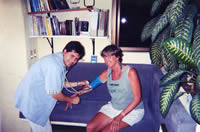 In
the event of a "hit," DAN vets you by phone, and although
my case was marginal they recommended we get to the recompression
chamber in Cabo San Lucas because of the apparent neurological involvement
demonstrated by the numbness along the "Ulna Pathway",
ie. the nerve running down the outside of my left arm and servicing
my outside two fingers. In my case it was more a question of potential
problems in the future than problems right now. DAN, bless them,
believes in the better-safe-than-sorry approach. In
the event of a "hit," DAN vets you by phone, and although
my case was marginal they recommended we get to the recompression
chamber in Cabo San Lucas because of the apparent neurological involvement
demonstrated by the numbness along the "Ulna Pathway",
ie. the nerve running down the outside of my left arm and servicing
my outside two fingers. In my case it was more a question of potential
problems in the future than problems right now. DAN, bless them,
believes in the better-safe-than-sorry approach.
Now Cabo San Lucas is at the very southern tip of
Baja, some 600 kilometers away. The chamber wanted me to come ASAP
(in theory I was already more than a day late for treatment!) and
was willing to send an ambulance for me! However, than seemed a
bit overkill in my circumstances, plus it would delay treatment
an additional six or seven hours for the round trip. Instead, thanks
to Budget of Loreto who delivered a rental car to usmin Puerto Escondido,
we were on the road by 5pm, an hour after our call! Too make a long
drive made mostly in the dark somewhat shorter, we arrived in Cabo
around 1:30 am. (A dinner stop and one small wrong turn out of La
Paz added about 45 minutes each. Hey, there was only supposed to
be one highway.)
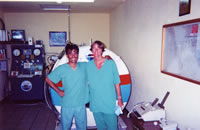 The
chamber technician, Antonio Luévanos was there to meet us,
and I was given a physical and neurological test at the hospital
before being carted off and stuffed promptly into the chamber for
five hours between 2:45 and 7:45 am, while Don was put to bed in
a back room. A recompression chamber is like being inside a big
scuba tank or a mini-submarine without water. There are two sections,
sealed by pressure hatches, potentially to allow two people to be
treated or to allow them to bring in equipment or personnel in emergencies.
There is just room enough for me to lie back while the attendant
crawls back and forth over you to check vital signs etc. A compressor
supplies air to pressurize the tank to approximately three atmospheres,
or about the equivalent pressure of 60' under water. This is sufficient
“depth” to recompress and dissolve any nitrogen bubbles
in your body tissues, which will then be expelled very gradually
through normal respiration in the course of a very long, slow (4
½ hours) “ascent”. The
chamber technician, Antonio Luévanos was there to meet us,
and I was given a physical and neurological test at the hospital
before being carted off and stuffed promptly into the chamber for
five hours between 2:45 and 7:45 am, while Don was put to bed in
a back room. A recompression chamber is like being inside a big
scuba tank or a mini-submarine without water. There are two sections,
sealed by pressure hatches, potentially to allow two people to be
treated or to allow them to bring in equipment or personnel in emergencies.
There is just room enough for me to lie back while the attendant
crawls back and forth over you to check vital signs etc. A compressor
supplies air to pressurize the tank to approximately three atmospheres,
or about the equivalent pressure of 60' under water. This is sufficient
“depth” to recompress and dissolve any nitrogen bubbles
in your body tissues, which will then be expelled very gradually
through normal respiration in the course of a very long, slow (4
½ hours) “ascent”.
The compressor
maintains the chamber pressure as old air is pumped out and exchanged.
This makes things rather warm inside, as pressurizing air heats
it. Now you'd think with five hours, you could catch up on your
sleep, which I was in dire need of, but actually things are pretty
busy in there. The second facet of the treatment is oxygen therapy,
which helps to wash out the nitrogen and to heal any damaged tissues.
Oxygen, under  pressure,
has to be closely monitored, hence the attendant. Riding with me
was a young fireman named Freddie who was gentle and attentive,
despite his Spanish being very difficult to understand. It seemed
like the oxygen mask was always going on or off. In the short breaks
when it's off, the attendant is checking pulse, blood pressure,
neurological signs and urging you to drink water. Hydration is important,
BUT it IS a five-hour stint, and although a bed pan is provided,
I can tell you it held NO ATTRACTION to me!!!! I was allowed to
have a book to read (potentially flammable items are strictly controlled,
with special clothes, blankets, medical equipment etc.) and then,
to combat potential claustrophobia, they project videos through
a porthole onto the curved tank wall next to you! Mind you there
is no speaker to accompany this fuzzy image, so the outside attendant
hikes of the volume to what must be for them ear-splitting levels
so that the patient has a chance to catch some of the dialogue (the
videos were in English!) through the tank walls, in between “Darth
Vader” breathing and noisy chamber pressurization adjustments!
It's a wonder Don could get any sleep in the back room. pressure,
has to be closely monitored, hence the attendant. Riding with me
was a young fireman named Freddie who was gentle and attentive,
despite his Spanish being very difficult to understand. It seemed
like the oxygen mask was always going on or off. In the short breaks
when it's off, the attendant is checking pulse, blood pressure,
neurological signs and urging you to drink water. Hydration is important,
BUT it IS a five-hour stint, and although a bed pan is provided,
I can tell you it held NO ATTRACTION to me!!!! I was allowed to
have a book to read (potentially flammable items are strictly controlled,
with special clothes, blankets, medical equipment etc.) and then,
to combat potential claustrophobia, they project videos through
a porthole onto the curved tank wall next to you! Mind you there
is no speaker to accompany this fuzzy image, so the outside attendant
hikes of the volume to what must be for them ear-splitting levels
so that the patient has a chance to catch some of the dialogue (the
videos were in English!) through the tank walls, in between “Darth
Vader” breathing and noisy chamber pressurization adjustments!
It's a wonder Don could get any sleep in the back room.
I can't say enough good about the whole Cabo San
Lucas operation. Antonio, Freddie and Angel (the usual tank operator)
were super. Also, the supervising physician Dr. Ibarra from the
Clinic de Especialidades that oversees the medical side of the operation.
After I popped out (gangway to the bathroom, por favor!), I had
another physical, some prescriptions to get (B vitamins, some drops
for my ears etc.) and a hotel to find. Cabo is the most expensive
place in Baja if not all of Mexico, and Don was major stressed over
the potentially mounting expenses (our hotel was $140/nite!) However
Antonio patiently connected him up with DAN accounting, who relieved
his stress by assuring us that we had $200/day extras coverage!
I also can't say enough about DAN and its patience!!! I was very
glad for the nice hotel room, because sleeping in the daytime is
not always easily managed, but it was a great bed, great air-conditioning,
and great drapes. Just two and a half-hours naptime and I felt like
a new person.
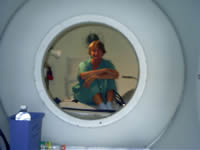 But
at 4pm, back into the chamber I went for a second five-hour treatment!
All in all this was a much easier session: got much of my book read,
slept for an hour, and even absorbed about half the Robin Williams
"Good Morning Vietnam" movie (bad choice for chamber showings
as you tend to hold your breath not to miss the audio!!!) However,
during the last thirty minutes, my left hand went numb again! This
was worrisome and puzzling. Dr. Ibarra's favorite neurological test
was the "touch and pinch" test where with my eyes closed
I had to identify whether he was touching me with a pin or one of
those rubber hammers all over the body! My results were mixed. However,
the numbness went away within an hour, Don and I caught a late dinner,
and with a whole night's sleep in the lovely hotel room, I was ready
to take the world by storm the next morning. I was due back for
a two-hour treatment at 10am, however, I'd come out the night before
to the news that there was another patient, an emergency patient,
being rushed in! Here the chamber had been quiet for a whole month,
and now two at once! However, the new guy, a commercial diver named
José whose job involved net maintenance in a tuna farming
operation, had arrived much later than anticipated (the ambulance
having had to stop on the way to get his condition stabilized),
so I was postponed until 2pm. This delay allowed us to enjoy the
culinary highlight of our trip, a real reuben sandwich at a restaurant
called Señor Greenberg's! But
at 4pm, back into the chamber I went for a second five-hour treatment!
All in all this was a much easier session: got much of my book read,
slept for an hour, and even absorbed about half the Robin Williams
"Good Morning Vietnam" movie (bad choice for chamber showings
as you tend to hold your breath not to miss the audio!!!) However,
during the last thirty minutes, my left hand went numb again! This
was worrisome and puzzling. Dr. Ibarra's favorite neurological test
was the "touch and pinch" test where with my eyes closed
I had to identify whether he was touching me with a pin or one of
those rubber hammers all over the body! My results were mixed. However,
the numbness went away within an hour, Don and I caught a late dinner,
and with a whole night's sleep in the lovely hotel room, I was ready
to take the world by storm the next morning. I was due back for
a two-hour treatment at 10am, however, I'd come out the night before
to the news that there was another patient, an emergency patient,
being rushed in! Here the chamber had been quiet for a whole month,
and now two at once! However, the new guy, a commercial diver named
José whose job involved net maintenance in a tuna farming
operation, had arrived much later than anticipated (the ambulance
having had to stop on the way to get his condition stabilized),
so I was postponed until 2pm. This delay allowed us to enjoy the
culinary highlight of our trip, a real reuben sandwich at a restaurant
called Señor Greenberg's!
 By
now the chamber staff was getting stretched a bit thin, hot-swapping
roles as chamber attendants and chamber operators day and night.
Angel had gone in with José, so this time Antonio himself
rode along with me. Before climbing in, Antonio had to lay out the
four cellular phones he carries, each for a different emergency
service! Talk about separation anxiety! Every time one of them would
ring, he’d be yelling to the outside tyring to find out what
was up! Again a smooth trip for me, but again, numbness my hands
in the last thirty minutes! Dr. Ibarra believed it was mostly likely
caused by stress, although I would say that I didn't feel especially
stressed by any of the chamber experience EXCEPT about the numbness.
But, again the numbness was gone within a couple of hours. By
now the chamber staff was getting stretched a bit thin, hot-swapping
roles as chamber attendants and chamber operators day and night.
Angel had gone in with José, so this time Antonio himself
rode along with me. Before climbing in, Antonio had to lay out the
four cellular phones he carries, each for a different emergency
service! Talk about separation anxiety! Every time one of them would
ring, he’d be yelling to the outside tyring to find out what
was up! Again a smooth trip for me, but again, numbness my hands
in the last thirty minutes! Dr. Ibarra believed it was mostly likely
caused by stress, although I would say that I didn't feel especially
stressed by any of the chamber experience EXCEPT about the numbness.
But, again the numbness was gone within a couple of hours.
The next morning I was not confident they would
release me. I knew Antonio was concerned about the numbness in hands
during the chamber “ascents,” even though there was
no logical reason for it. On top of that, Don and I had made a bad
call on the evening meal -- too-salty roast chicken -- and I woke
as dehydrated as I might have felt after drinking too many margaritas.
NOT! However, I passed all the tests with flying colors, and, to
Don’s and my amazement, was released. The only hitch to getting
back home to the boat was that I was not allowed cross the highest
part of the mountains until after 72-hours. So we drove as far as
La Paz, which was much less expensive than Cabo, visited with friends,
bought boat stuff, and shopped in supermarkets with major vegetable
aisles. When we finally crossed back into Puerto Escondido, the
car was full!
I say all these nice things about the chamber personnel,
but the real hero to me was Don. First off he drove me all night
to get there. Then he dealt with all the phone calls to DAN accounting
departments etc. When I'd pop out of the chamber or wake up from
my nap, he'd have waiting some special treat like a chocolate chip
cookie or a fresh fruit batido (shake). Think of all the years of
diving I had where I was without such a support system! Needless
to say, his experience of Cabo San Lucas was a little different
than mine. In those hours when I was in the chamber he'd deal with
Internet stuff (Terry was back watching the boat and Don was long-distance
fretting about amps in and out, weather, etc.). Then he'd regale
me with stories about all the characters he'd met during his day
(Gee, most of them were female!!???!!!) and replay all of his struggling
conversations in Spanish!
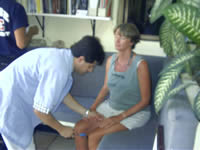 So,
when all is said and done, it was an interesting experience I certainly
hope not to have to repeat. Being a mostly conservative diver, I
had every reason to expect to make it through my diving career never
having seen the inside of a chamber, and I certainly didn't expect
it to happen in such non-event conditions as these were, particularly
since I am in the best physical condition I have been in years!!!!!
It turns out that 80% of the DCS (decompression sickness) cases
that DAN deals with are divers who, like me, violated no safe diving
principles. There is some speculation that there is an increased
incidence of non-earned DCS among women in my age range, who are
experiencing hormonal changes and/or may be on some kind of hormone
treatment! Goodness, that includes alot of us! So,
when all is said and done, it was an interesting experience I certainly
hope not to have to repeat. Being a mostly conservative diver, I
had every reason to expect to make it through my diving career never
having seen the inside of a chamber, and I certainly didn't expect
it to happen in such non-event conditions as these were, particularly
since I am in the best physical condition I have been in years!!!!!
It turns out that 80% of the DCS (decompression sickness) cases
that DAN deals with are divers who, like me, violated no safe diving
principles. There is some speculation that there is an increased
incidence of non-earned DCS among women in my age range, who are
experiencing hormonal changes and/or may be on some kind of hormone
treatment! Goodness, that includes alot of us!
I left Tackless for the chamber half thinking this
was the end of my diving career, because, well, who needs that kind
of suspense? Especially, out in the boonies as we are! And this
female susceptibility should only reinforce that inclination. To
my surprise, however, all parties both at the chamber and at DAN
do not see any reason to consider not resuming diving and there
are no penalties in the DAN membership/insurance on those who have
had DCS. This is very encouraging news since diving has always been
very important to me and we have so much of the world left to see.
I have to wait 45 days before I can dive again, so I have some time
to learn more about this and to find out what strategies (if any)
DAN may be developing for women in this category. We have just learned
about a dive computer (the Suunto Vyper), into which you can program
some personal adjustment parameters.
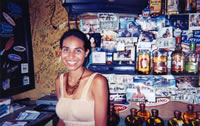 Finally,
the trip did take us to parts of Baja we would not otherwise have
seen. Glitzy Cabo San Lucas was nice to have checked out, particularly
in its relatively relaxed, low season mode. We would not likely
ever go there with the boat, as slips are absurdly expensive. The
drive between was quite interesting, especially with a copy of "The
Roadside Geology of Baja" in our lap which ticks off observations
of local geology, botany and biology by kilometer signposts! It
is all incredibly arid and sun-beaten, but there were a half dozen
very distinct regions, the most striking of all being that last
mountain range, the Sierra Gigantica that towers over of Puerto
Escondido, which are like vertical edifices with domes and turrets. Finally,
the trip did take us to parts of Baja we would not otherwise have
seen. Glitzy Cabo San Lucas was nice to have checked out, particularly
in its relatively relaxed, low season mode. We would not likely
ever go there with the boat, as slips are absurdly expensive. The
drive between was quite interesting, especially with a copy of "The
Roadside Geology of Baja" in our lap which ticks off observations
of local geology, botany and biology by kilometer signposts! It
is all incredibly arid and sun-beaten, but there were a half dozen
very distinct regions, the most striking of all being that last
mountain range, the Sierra Gigantica that towers over of Puerto
Escondido, which are like vertical edifices with domes and turrets.
And in the end,
a few nights of hotel luxury were not wasted on us either. We were,
however, very glad to finally get home.
|